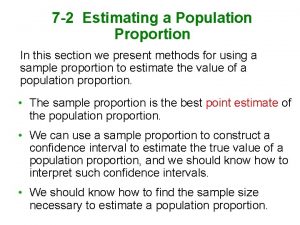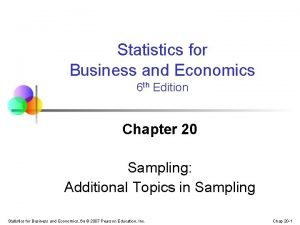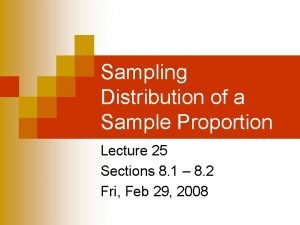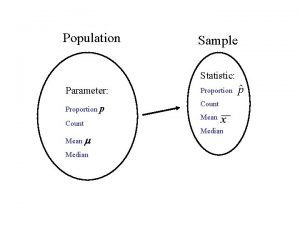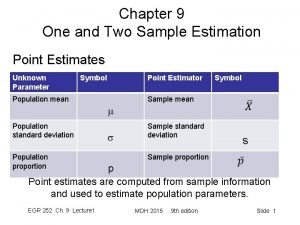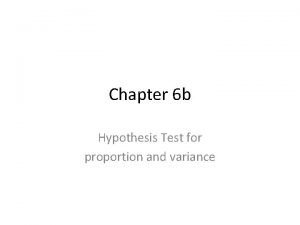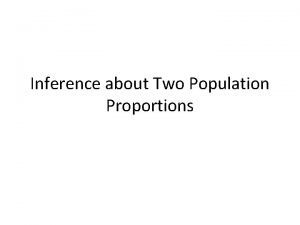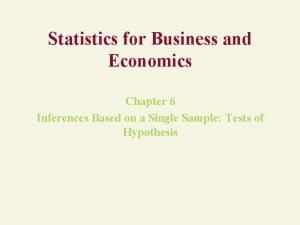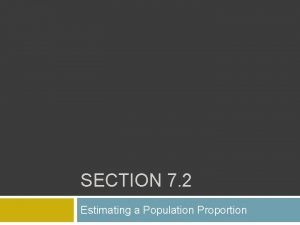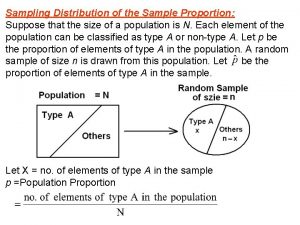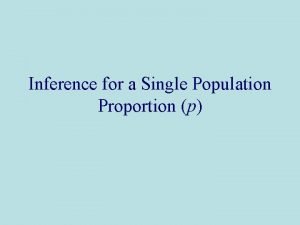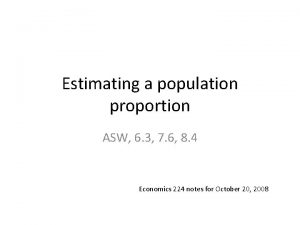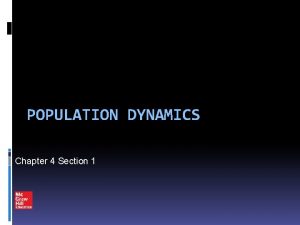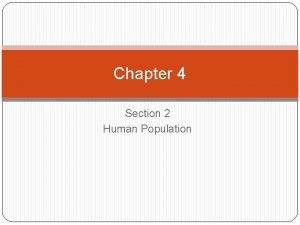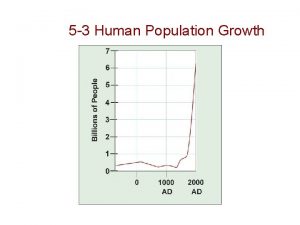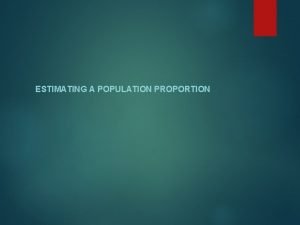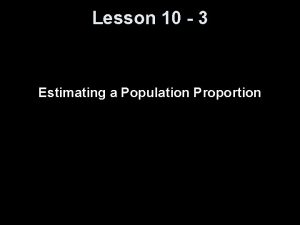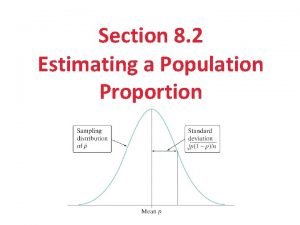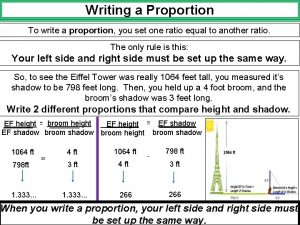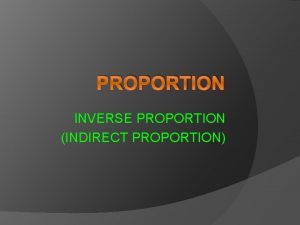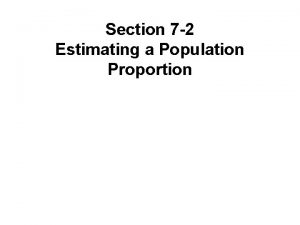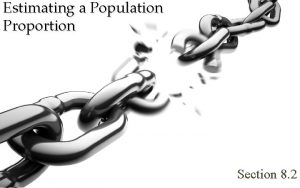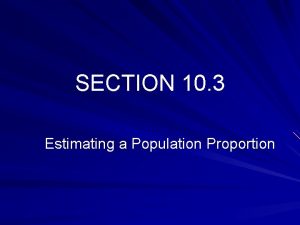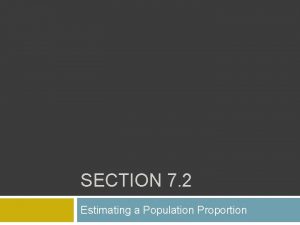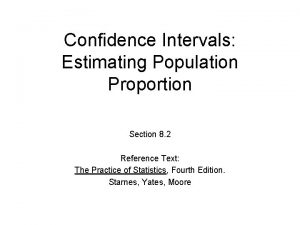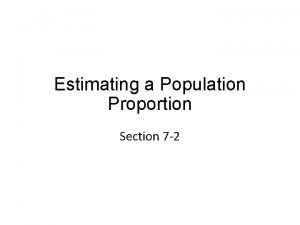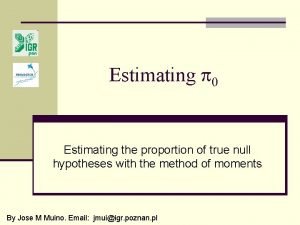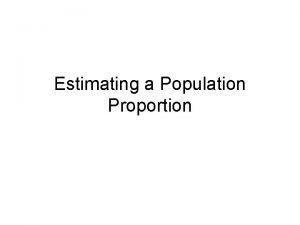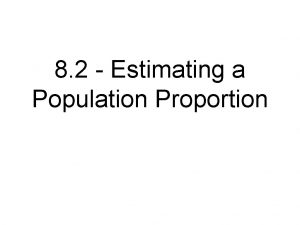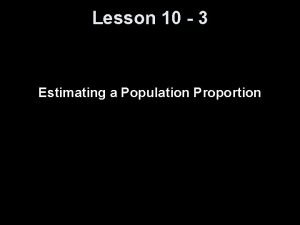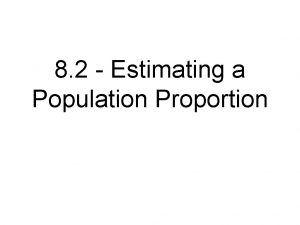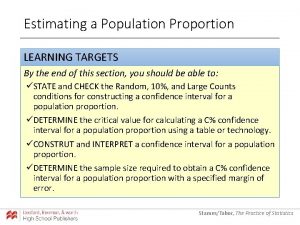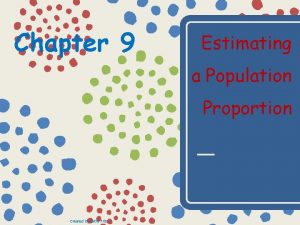SECTION 7 2 Estimating a Population Proportion Where
























- Slides: 24

SECTION 7. 2 Estimating a Population Proportion

Where Have We Been? In Chapters 2 and 3 we used “descriptive statistics”. We summarized data using tools such as graphs, mean, and standard deviation.

Where Are We Going? In Chapter 6 we began using “inferential statistics”. � We will be using sample data to make inferences about population parameters.

Goals – Ideas to Understand 1. 2. 3. 4. Find the best point estimate of the population proportion. Express confidence intervals and interpret their results. Locate critical values. Compute the margin of error.

Topic 1 – Point Estimate of a Population Definition Point Estimate: A single value (or point) used to approximate a population parameter. Important Notes If we want to estimate a population proportion with a single value, the best estimate is the sample proportion. � Unbiased (Section 6. 7)

Topic 1 - Example In a Pew Research Center poll, respondents were asked “From what you’ve read and heard, is there solid evidence that Kayla Williams is missed in her 1 st hour class whenever she is absent? 95% of 1501 randomly selected adults in the U. S answered yes. Find the best point estimate of the proportion of all adults in the U. S who believe in The best estimate is 95%. missing Kayla.

Topic 1 - Check Yo Self! In a Pew Research Center poll, respondents were asked “From what you’ve read and heard, is there solid evidence that the average temperature on earth has been increasing over the past few decades, or not? 70% of 1501 randomly selected adults in the U. S answered yes. Find the best point estimate of the proportion of all adults in the U. S who believe in Warming. The. Global best estimate is 70%.

Topic 1 - Flaws 70% was our best point estimate of the population proportion p, but we have no idea of just how GOOD our best estimate is. THINK: I could give you my best estimate for how awesome snails are. However, given my experience is based on only three snails, how good of a estimate is that for every snail?

Introducing … TOPIC 2 – CONFIDENCE INTERVALS

Topic 2 – Confidence Intervals Definition Confidence Interval: A range (or interval) of values used to estimate the true value of a population parameter. Abbreviated CI. Important Notes A confidence level is expressed as the probability or area 1 – , where is the complement of the confidence level. � Most common choices are 90%, 95%, or 99%. This means (α = 10%), (α = 5%), (α = 1%)

Topic 2 – Interpreting Confidence Intervals Correct: � “We are 95% confident that the interval from 0. 677 to 0. 723 actually does contain the true value of the population proportion p. ” � This means that if we were to select many different samples of size n and construct the corresponding confidence intervals, 95% of them would actually contain the value of the population proportion p. � Refers to the process.

Topic 2 – Interpreting Confidence Intervals Incorrect: � “There is a 95% chance that the true value of p will fall between 0. 677 and 0. 723. ” � “ 95% of sample proportions fall between 0. 677 and 0. 723. ” A confidence interval either contains p or it does not. That is why it is incorrect to say there is a 95% chance that p will fall between 0. 677 and 0. 723.

Topic 3 – Critical Values A standard z score can be used to distinguish between sample statistics that are likely to occur and those that are unlikely to occur. Such a z score is called a critical value. Definition Critical Value: The number on the borderline separating sample statistics that are likely to occur from those that are unlikely to occur.

Topic 3 – Critical Clarification The number z /2 is a critical value that is a z score with the property that it separates an area of /2 in the right tail of the standard normal distribution.

Topic 3 – Critical Example 1. 2. 3. Finding zα/2 for a 95% Confidence Level Find /2 Subtract the result from 1. Find the corresponding z score.

Topic 3 – Check Yo Self! Confidence Level 90% 95% 99% 0. 10 0. 05 0. 01 Critical Value, z /2 1. 645 1. 96 2. 575

Topic 4 – Margin of Error Definition Margin of Error: When data from a simple random sample are used to estimate a population proportion p, the margin of error, denoted by E, is the maximum likely difference (with probability 1 – , such as 0. 95) between the observed proportion and the true value of the population proportion p.

Topic 4 – Margin of Error Formula Important Notes Margin of Error for Proportions

Topic 4 – Check Your Self Assume that a sample is used to estimate a population proportion p. Find the margin of error, E, that corresponds to the given statistics and confidence level. Round the margin of error to three decimal places. 90% confidence, sample size is 500, 20% are successes. a) 99% confidence, sample size is 300, 25% are successes. b)

Topic 2 – Expressing A Confidence Interval 3 different ways to write a confidence interval

Topic 2 – Check Yo Self Assume that a sample is used to estimate a population proportion p. Find the margin of error, E, that corresponds to the given statistics and confidence level. Round the margin of error to three decimal places. 90% confidence, sample size is 500, 20% are successes. a) 99%***Now confidence, sample your size is answers 300, 25% are express successes. b) from before as an interval.

Topic 3 – Point Estimate and E Finding the Point Estimate and E from a Confidence Interval

Goals – Ideas to Understand 1. 2. 3. 4. Find the best point estimate of the population proportion. Express confidence intervals and interpret their results. Locate critical values. Compute the margin of error.

Homework: p. 340 -341 #5 -8 (Finding Critical Values) #9 -10 (Expressing/Interpreting CI) #17 -20 (Finding Margin of Error)
 Estimating a population proportion
Estimating a population proportion Chapter 4 section 1 population dynamics study guide
Chapter 4 section 1 population dynamics study guide Section 1 population dynamics
Section 1 population dynamics Population ecology section 1 population dynamics
Population ecology section 1 population dynamics Chapter 4 section 1 population dynamics
Chapter 4 section 1 population dynamics Variance of population proportion
Variance of population proportion Population proportion symbol
Population proportion symbol What is a sample in statistics
What is a sample in statistics Point estimation
Point estimation Hypothesis testing for population proportion
Hypothesis testing for population proportion Population proportion definition
Population proportion definition Statistics for business and economics chapter 6 solutions
Statistics for business and economics chapter 6 solutions Section
Section What is a sample proportion
What is a sample proportion Population proportion
Population proportion What is the population proportion
What is the population proportion Similarity ratio definition
Similarity ratio definition Chapter 4 section 1 population dynamics
Chapter 4 section 1 population dynamics Chapter 4 section 2 human population
Chapter 4 section 2 human population Chapter 4 section 2 human population answer key
Chapter 4 section 2 human population answer key Whats a density dependent factor
Whats a density dependent factor Chapter 4 section 2 population geography
Chapter 4 section 2 population geography Section 5-3 human population growth
Section 5-3 human population growth Chapter 9 the human population section 1
Chapter 9 the human population section 1 Types of tps
Types of tps
